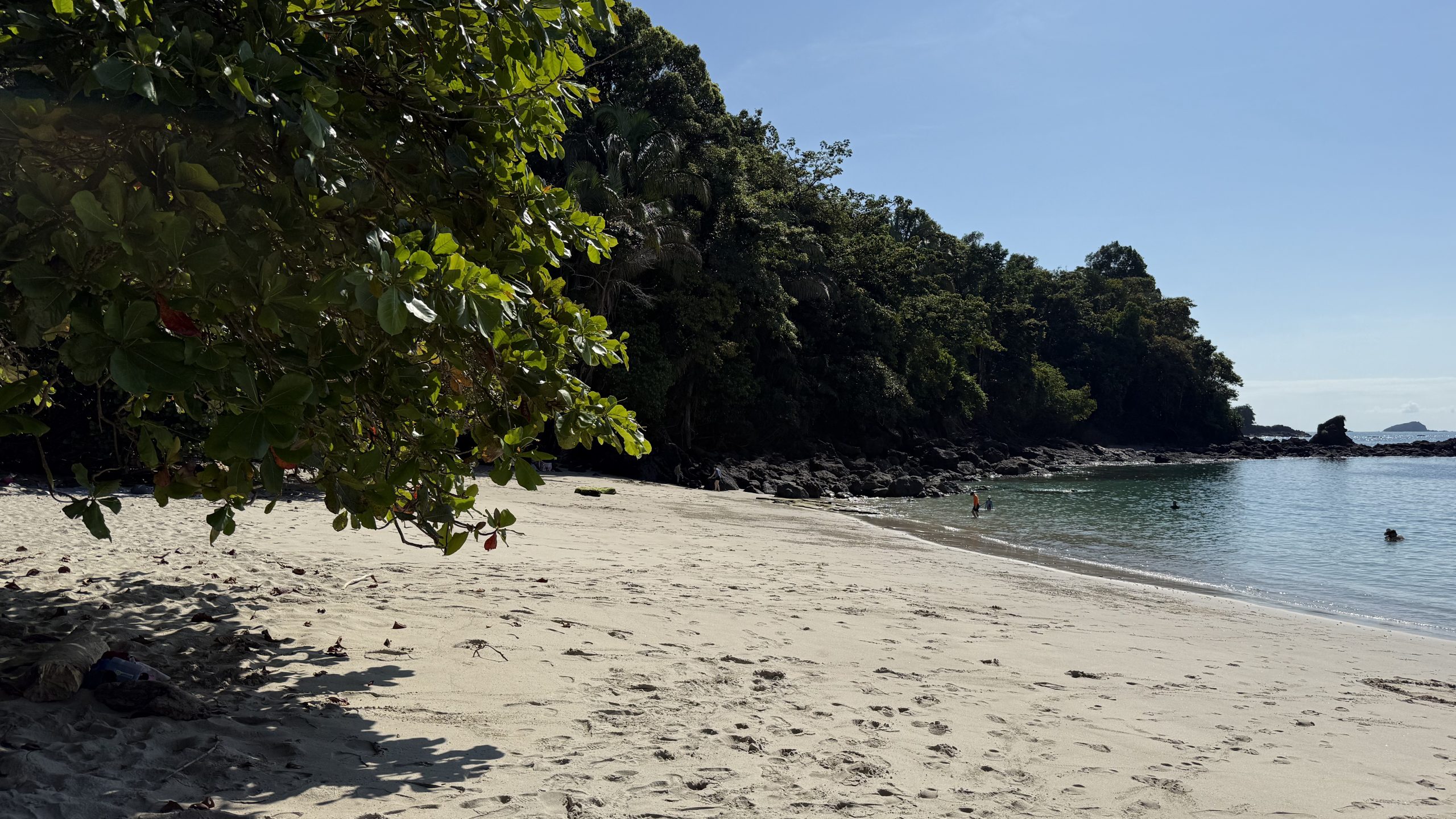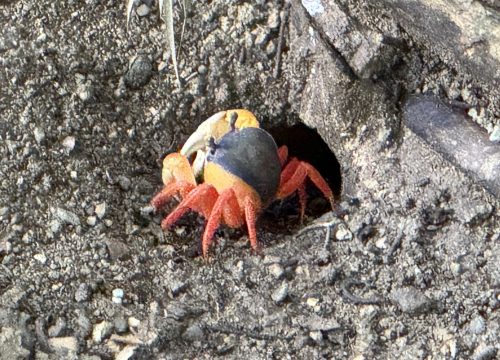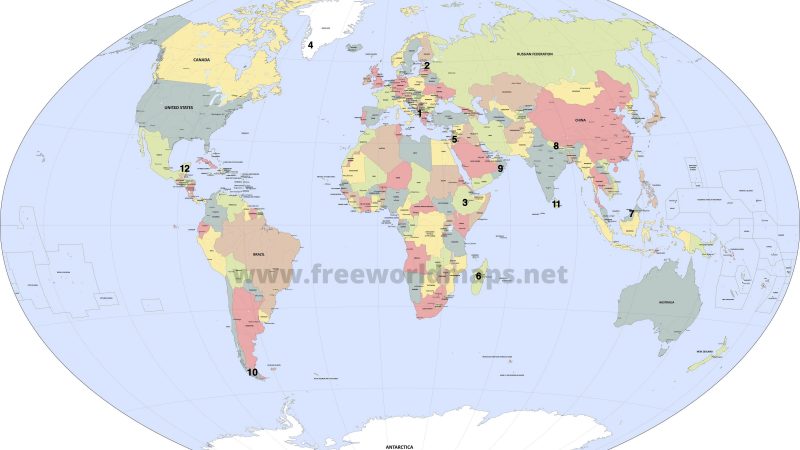Costa Rica’s smallest, yet most popular national park is called Manuel Antonio. It’s on the country’s central Pacific coast, and a visit there is part of many a Costa Rican travel itinerary. But why, and should it be part of YOUR itinerary?
Read on to find out why you should, or maybe shouldn’t, pay this park a visit on your trip to the land of ‘Pura Vida’!
Table of Contents
5 reasons TO visit Manuel Antonio
1. It’s compact.
If you want to visit a coastal rainforest setting but are short on time, Manuel Antonio is definitely a good choice. At less than 7 km2 (2.7 mi2) it’s pint-sized but packs a lot into that little space.
Even if you just have half a day, that’s still enough time to explore many of the trails, pausing to spot wildlife and take pictures, plus enjoy a swim at one of the park’s beaches. And you won’t come away with the feeling that you only saw a fraction of the park’s territory.
2. It’s great for families or those with limited mobility.
If you’re traveling with small children or a member of your party has difficulty walking or uses a wheelchair, Manuel Antonio is a very good option.
Costa Rica isn’t known for being disabled-friendly, but this park is one of the exceptions. There are lots of well-maintained and relatively flat pathways in the park, making most of its main paths feasible for wheelchair users or anyone who can’t walk very far. A reasonable number of benches also provide regular space to sit and rest while making your way around, and there are plenty of accessible restrooms available.
For kids, the combination of a compact territory and a beautiful, child-friendly beach is a winner. Note to parents: you can’t bring any outside food (they don’t want people feeding the animals), but there is food available for purchase and consumption in designated areas, and you can bring your own beverages in reusable containers (no single-use plastic allowed!).
3. It’s easy to reach.
Costa Rica might be a small country, but it’s not always easy or quick getting around! Manuel Antonio is ideally located, however, right about in the middle of the western (Pacific) coast. The drive from San José’s airport is only about 3 hours along well-maintained roads, and many buses ply the route from San José, Jacó and other nearby destinations.





4. You can see a lot of wildlife.
All sorts of critters can be spotted at Manuel Antonio, such as monkeys, sloths, iguanas, insects and hundreds of bird species. All of this can be accomplished without having to trek large distances, or even venture off the main pathways (note that even if you take one of the less trodden paths, you MUST remain on the path).
I’ll take this opportunity to mention that I HIGHLY recommend hiring a guide. While it adds to the cost of your visit, it’s money well spent because unless you’re an expert wildlife spotter, you’re likely to miss out on seeing so many things because you simply won’t know where to look.
A word about guides: we hired an independent guide just outside the park’s entrance, and worried that we’d been scammed once we saw the official guide kiosk a few meters inside. Our guide did well, however; he came equipped with the telescope that’s necessary to see things up close and he clearly knew a lot about the flora and fauna of the area. We lucked out, but if you want to be sure to have a knowledgeable and professional guide, refuse any official-looking individuals on the street and go directly to the kiosk on your right at the park’s entrance.

5. The beaches are very nice!
There are several beaches in the park, the most popular being the lovely and family-friendly Manuel Antonio beach. There’s also a beach with more waves present, but be advised that there can be a strong undercurrent, and that you swim at your own risk.
If you’re looking to follow up your wildlife exploration with some relaxation and/or a swim, Manuel Antonio National Park is a great place to visit!

5 reasons NOT to visit Manuel Antonio
1. It’s crowded.
There’s just no other way to put it. The combination of being Costa Rica’s smallest national park and at the same time its most popular, means that you’ll struggle to find anything approaching solitude. Even getting outside the sight or earshot of other people for a few moments can be a formidable challenge, in the December to April high season at least.
2. It’s expensive.
As a party of three, we spent US$56 each for admission and a guide hired for two hours. This isn’t terrible, but if you compare it to (for instance) Parque Nacional Cahuita on the Caribbean coast, where we spent about half as much for a similar experience, it’s clear that Manuel Antonio is no bargain.
Lodging and dining near the park are equally pricey compared to other locales, so all in all the overnight and two half-days we spent there were the most expensive of our trip.
3. The park and surrounding areas are very touristy.
This point sort of leads on from the previous two; while the park is protected land and the continuing presence of wildlife indicates that authorities are doing at least a decent job of preserving its ecosystems, unspoiled nature it isn’t.
Ditto for Manuel Antonio village. It’s built for and caters to tourism and pretty much nothing else. Locals live in nearby Quepos or further afield, so if you want to experience a local Tico village, look elsewhere.


4. Other parks/protected areas can offer better wildlife viewing.
This can be difficult to compare – because well, animals aren’t there to pose for pictures or be our entertainment, so experiences can vary. But for me Parque Nacional Cahuita (another compact national park on the Caribbean coast) or Parque Nacional Corcovado (for anyone in pursuit of the ‘Pura Vida’ vibe) were much more memorable for wildlife spotting and as coastal rainforest ecosystems.
And at the risk of pointing out the obvious, critters don’t exclusively live in national parks, folks! There are lots of protected areas, both public and private, as well as animal rescue and rehabilitation facilities that are doing some fantastic conservation work. And you can visit many of these places. Just one example, located less than a 30-minute drive from Manuel Antonio: a wildlife rescue center called Kids Saving the Rainforest. There are similar projects throughout the country, just waiting to be visited.



5. The overall experience feels rather ‘packaged’.
Sorry to say this, but I left Manuel Antonio with the overall feeling that I’d had a very Disneyesque experience. Not in the sense of things being fake, because of course the animals and scenery are very much real. More so I mean that the space is highly curated for tourists, which can have its advantages but isn’t generally what I’m looking for when I travel.
So, you may be wondering, why did I go? Well, I knew beforehand that it was popular and was going to be touristy. But I was traveling with my mother (who has somewhat limited mobility) and I thought the ease of visiting this place would be great for her. The reality: she also had a better experience in other places that we visited!
Summary
As you perhaps now see, whether or not you should visit Parque Nacional Manuel Antonio as part of your trip to Costa Rica very much depends upon you, your preferences, and your circumstances.
If you’re looking for a little wildlife viewing alongside a day at the beach, are pressed for time and don’t mind a lot of other visitors around you, Manuel Antonio could be a great choice for you. It also does a much better job than some other Costa Rican parks at accommodating disabled guests.
But if you prefer a quieter and less touristy experience, and don’t mind making a small effort to find it, there may be better options out there for you.
IF you decide to visit: my tips!
- Buy your ticket at least a day or two in advance.
- The park limits visitor numbers and staggers entry times (this is a good thing!) so don’t expect to be able to just show up and buy tickets the same day. Go to this website to buy tickets; note that you must sign up for an account and that not all of the website is translated to English, so you may have to request some help navigating. Note that you’ll also need to select your entry time when you make your purchase.
- If possible, try to book your ticket for right when the park opens at 7 AM. It will be less crowded, certain wildlife can be more easily spotted, and it’ll be cooler!
- Be aware that the park is closed on Tuesdays year-round.
- Expect parking to be a challenge.
- There is limited paid parking a short walk from the entrance (along Calle Parque Nacional and near Hotel Manuel Antonio), but on busy days it can fill up fast and the whole area can get very congested. My advice is to try to arrange transportation through your lodging or stay within walking distance of the park’s entrance.
- Do Bring: sun protection, insect repellant, closed shoes if you plan to go off the main path, binoculars (if you have them), a reusable water bottle (refills available in the park) and a swimsuit and towel if you plan to swim.
- Don’t Bring: food or any single-use plastic, aerosols of any kind, beach umbrellas or furniture (note that there is shade available in many places, including near/on the beach). Pets also need to stay home.
Share your thoughts!
Did you visit Manuel Antonio on your trip to Costa Rica? If so, what did you think?
I love to hear from my readers, so let me know your thoughts in the ‘Leave a Reply’ section below!
Thanks for reading, and stay tuned for more reports from my recent trip to the land of pura vida!




